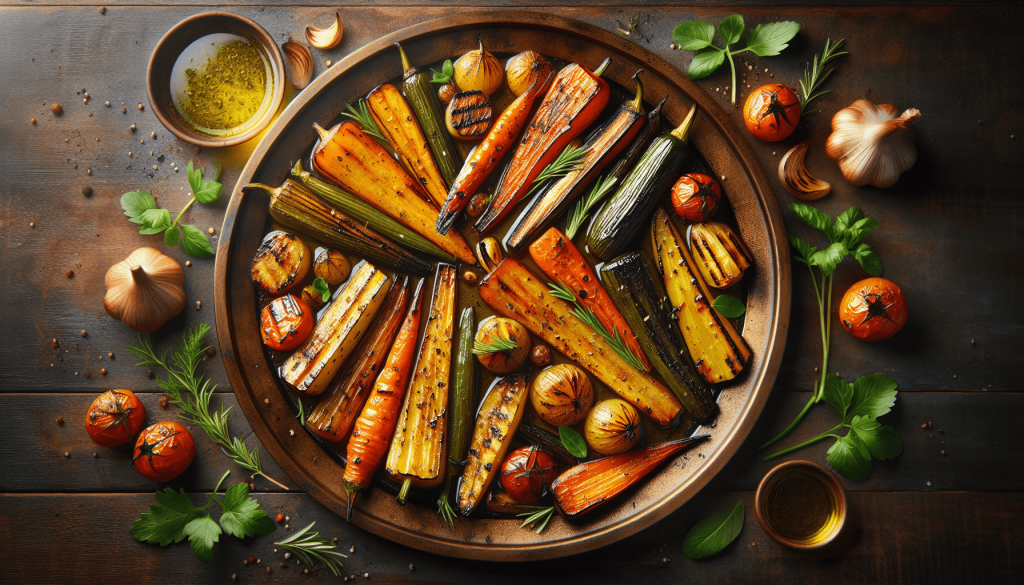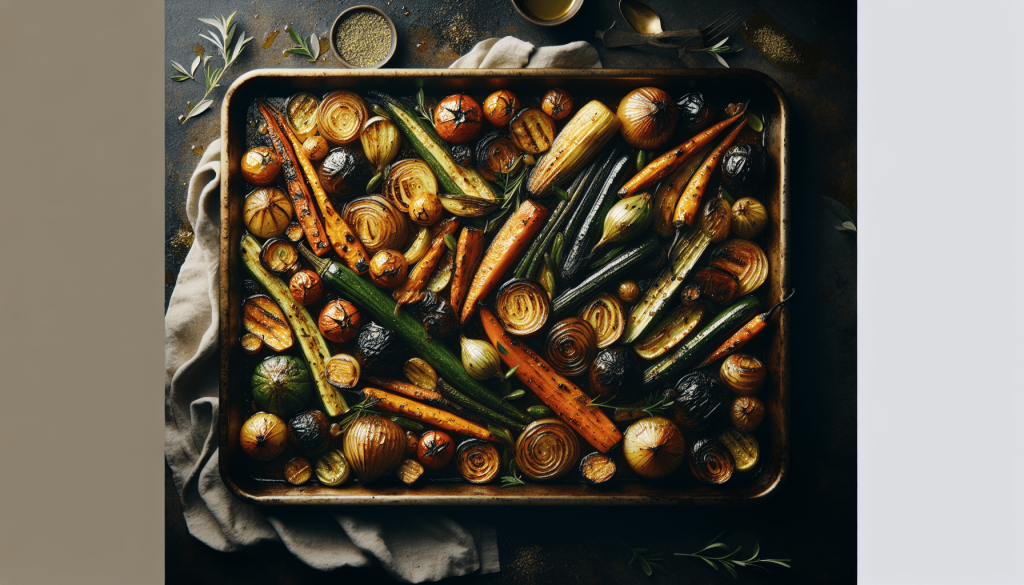If you’ve ever struggled to achieve that irresistible crispy texture and amazing flavour in your roasted vegetables, fret not, for we have got you covered! In this article, we will be sharing the most invaluable cooking tips that will elevate your roasted vegetables to another level of deliciousness. From selecting the right veggies to mastering the perfect roasting temperature, you’ll soon be savoring perfectly caramelized and tender vegetables that will leave everyone at the dinner table asking for seconds. So, grab your apron and get ready to become a roasted vegetable maestro!
Choosing the Right Vegetables
When it comes to roasting vegetables, the first step is to choose the right ones. Look for fresh and firm vegetables, as they are ideal for roasting. Avoid vegetables that are soft or have visible signs of wilting. The firmness of the vegetables ensures that they hold up well during the roasting process, resulting in a delectable final dish.
In addition to freshness, it’s also important to choose a variety of colors. Vegetables come in a wide range of colors, and each color offers different nutritional benefits. By incorporating a variety of colors into your roasted vegetables, you can ensure that you are getting a well-rounded mix of essential vitamins and minerals. Plus, a vibrant mix of colors adds visual appeal to your dish, making it even more inviting.
Opting for seasonal vegetables is another wise choice. Seasonal vegetables are not only fresher, but they also tend to be more flavorful. When vegetables are in season, they are harvested at their peak ripeness, ensuring that you get the best taste and texture when you roast them. Seasonality also allows you to support local farmers and reduce the carbon footprint associated with transporting out-of-season produce.
Preparation Techniques
Before you start roasting your vegetables, it’s important to prepare them properly. Thoroughly wash the vegetables to remove any dirt or debris that may be clinging to them. This step is especially crucial if you are using organic vegetables, as they may have a little extra soil on them.
Peeling or trimming the vegetables is necessary in some cases. For instance, if you’re using carrots or potatoes, you may want to peel them to achieve a smoother texture. However, some vegetables, like butternut squash or zucchini, can be roasted with their skin intact for added flavor and texture. Trim any ends or stems that are tough or inedible to ensure that every bite of your roasted vegetables is enjoyable.
Cutting the vegetables into even sizes is essential for even cooking. When the vegetables are cut into similar sizes, they will cook at the same rate, ensuring that all the pieces are perfectly roasted. Use a sharp knife or a mandoline slicer to achieve uniform slices or cubes. Consistency in size will result in a dish that is visually appealing and has a uniform texture.

Seasoning and Flavorings
To bring out the best flavor in your roasted vegetables, it’s important to season them properly. Olive oil is an excellent choice for roasting vegetables, as it adds richness and a subtle nutty flavor. Toss the vegetables in olive oil to ensure that they are evenly coated before roasting. The oil also helps to prevent the vegetables from drying out during the cooking process.
In addition to olive oil, you can enhance the flavor of your roasted vegetables by adding herbs and spices. Herbs like rosemary, thyme, and oregano add a fragrant aroma, while spices like cumin, paprika, or curry powder add a hint of warmth and complexity. Experiment with different flavor combinations to find your favorite, and don’t be afraid to get creative with your seasonings.
Speaking of creativity, don’t be afraid to try different seasonings on your roasted vegetables. While olive oil, herbs, and spices are classic choices, there are no hard and fast rules. You can experiment with different seasonings, such as soy sauce, balsamic vinegar, or even a sprinkle of Parmesan cheese. The key is to have fun and create flavors that you and your family enjoy.
Proper Roasting Temperature
Getting the roasting temperature right is crucial for perfectly roasted vegetables. Preheat your oven to the right temperature before putting the vegetables in. Most roasted vegetables do well at a moderate to high temperature, around 400 to 425°F (200 to 220°C). This ensures that the vegetables cook evenly and develop a lovely caramelized exterior while remaining tender on the inside.
However, it’s essential to adjust the temperature based on the hardness of the vegetables you are roasting. Softer vegetables, like peppers or zucchini, will require a slightly lower temperature to prevent them from becoming too soft or mushy. On the other hand, harder vegetables, like potatoes or root vegetables, can handle a higher temperature to develop a crispy and golden exterior.
Consider using high and low heat methods for different vegetables. For example, you can start roasting at a high temperature to create a nice sear or char on the outside, then reduce the temperature to finish cooking the vegetables more gently. This technique adds depth of flavor, as the initial high heat caramelizes the natural sugars in the vegetables, resulting in a rich and slightly smoky taste.

Choosing the Right Cooking Pan
Choosing the right cooking pan is essential for achieving perfectly roasted vegetables. A heavy-duty baking sheet or roasting pan is ideal, as it conducts and retains heat well, ensuring even cooking throughout. Avoid using thin or flimsy pans, as they can lead to uneven cooking and potentially burn the vegetables.
The size of the pan is equally important. Make sure to use a pan that provides sufficient space for the vegetables to spread out in a single layer. Crowding the pan can lead to steaming instead of roasting, resulting in vegetables that are soft and lack that desirable caramelized exterior. Giving the vegetables enough room will enable proper heat circulation, ensuring that each piece cooks evenly.
Consider using non-stick pans or lining the pan with parchment paper for easier cleanup. Roasted vegetables tend to develop a caramelized coating, which can sometimes stick to the pan. Using a non-stick pan or lining it with parchment paper prevents the vegetables from sticking, making cleanup a breeze.
Arranging Vegetables for Even Roasting
The way you arrange the vegetables on the pan plays a significant role in achieving evenly roasted goodness. Avoid overcrowding the pan, as this can prevent proper heat circulation and lead to steaming instead of roasting. When the vegetables are spaced too closely together, they release moisture, causing them to become soft and mushy rather than caramelized and crisp.
Instead, spread the vegetables in a single layer on the baking sheet or roasting pan. This ensures that each piece has enough exposure to the heat, allowing them to develop that beautiful golden-brown color and irresistible crunch. If you have a large batch of vegetables, it’s better to use multiple pans rather than crowding them all onto one.
Leave some space between the vegetables as well. Leaving a small gap between each piece helps to promote even browning, as it allows hot air to circulate around the vegetables. This results in a more uniform roasting, with each piece of vegetable cooked to perfection.
Roasting Techniques
To achieve perfectly roasted vegetables, it’s important to employ the right roasting techniques. Flip or stir the vegetables halfway through the cooking time to ensure that all sides are evenly cooked. This technique helps prevent any piece from becoming overly charred or undercooked, resulting in a harmonious blend of flavors and textures.
Basting the vegetables with oil or sauce during the roasting process can enhance their flavor and moistness. Brushing the vegetables with oil or drizzling them with a flavorful sauce helps to infuse them with additional moisture and ensures that they remain tender and succulent. Plus, it adds an extra layer of flavor that can take your roasted vegetables to the next level.
Consider using a roasting rack for better air circulation. Placing a roasting rack on top of your baking sheet or roasting pan allows hot air to circulate underneath the vegetables, resulting in more consistent browning. It also helps to prevent the vegetables from sitting in accumulated juices, keeping them crisp and delicious.
Cooking Time and Checking for Doneness
To achieve perfectly roasted vegetables, it’s crucial to follow the recommended cooking times. The cooking time varies depending on the size and hardness of the vegetables, as well as the desired tenderness. Keep an eye on the vegetables as they roast and adjust the cooking time accordingly to ensure they reach your desired doneness.
To check the doneness of the vegetables, you can use a fork or knife to pierce them. The vegetables should be tender but still have some resistance when pierced. Avoid overcooking them, as they can become mushy and lose their vibrant flavors. It’s better to slightly undercook the vegetables, as they will continue to cook slightly once removed from the oven.
Enhancing Texture and Flavor
To elevate the texture and flavor of your roasted vegetables, you can incorporate a few additional techniques. Roasting vegetables at a high temperature for a short period of time helps to achieve crispness and caramelization. This technique is especially effective for vegetables like Brussels sprouts or cauliflower, which develop a delightful crunch when roasted at high heat.
For a touch of sweetness, consider drizzling honey or maple syrup over the vegetables before roasting. The natural sugars in these sweeteners caramelize during the cooking process, adding a subtle sweetness that complements the savory flavors of the roasted vegetables. This technique works particularly well with root vegetables like carrots or sweet potatoes.
Adding a crunchy topping is another tempting option to consider. Sprinkle breadcrumbs, crushed nuts, or grated cheese over the vegetables before roasting to add a delightful texture and a burst of flavor. The crispy topping creates a contrast with the tender roasted vegetables, making every bite a delightful sensory experience.
Serving Suggestions
Now that you have perfectly roasted vegetables, it’s time to enjoy them. Roasted vegetables make a wonderful side dish for any meal. Serve them alongside grilled meats or fish, or add them to a delicious vegetarian bowl. Their flavors and textures also make them a great addition to salads or pasta dishes, providing a burst of color and added depth.
Consider incorporating roasted vegetables into sandwiches for a satisfying and flavorful meal. Layer them on toasted bread or a roll, along with some fresh greens and a tangy dressing, for a delightful twist on a classic sandwich. Roasted vegetables add a deliciously hearty and satisfying element to any sandwich creation.
In conclusion, by following these tips on choosing the right vegetables, preparing them correctly, seasoning and flavoring them to perfection, roasting them at the proper temperature, and using the right cooking pan and techniques, you can achieve a dish of perfectly roasted vegetables. With some creativity and experimentation, you can create a range of flavors and textures that will make your roasted vegetables a hit at every meal. So go ahead, grab some fresh and colorful vegetables, and get ready to roast your way to vegetable perfection!
